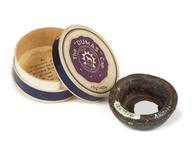

Dissecting forceps used by Patrick Steptoe
- Made:
- unknown in unknown place

Long-handled dissecting forceps, 1970-1975. Used for tubal ligation procedures by Patrick Steptoe (1913-1988) at the Centre for Human Reproduction, Oldham.
Tubal ligation is a surgical procedure for sterilisation which involves clamping with clips the fallopian tubes, preventing eggs from reaching the uterus. This instrument was used to by Patrick Steptoe (1913-1988) to perform the operation at Oldham General Hospital, Greater Manchester, in the early 1970s.
Steptoe pioneered the use of laparoscopy or keyhole surgery in Britain for the diagnosis and treatment of gynaecological conditions, and the technique played a critical role in the development of IVF, allowing eggs to be collected from the ovaries of volunteers without the need for invasive open surgery.
During the 1970s Steptoe and Robert Edwards (1925-2013) developed in vitro fertilisation (IVF), with Jean Purdy resulting in the birth of the world’s first ‘test-tube baby’, Louise Brown, in 1978. Edwards was awarded the 2010 Nobel Prize in Physiology or Medicine for his work on the development of IVF Steptoe was ineligible because the Nobel Prize is not awarded posthumously.
Details
- Category:
- Obstetrics, Gynaecology & Contraception
- Object Number:
- 2019-412
- Materials:
- metal (unknown)
- Measurements:
-
overall: 13 mm x 416 mm x 148 mm,
- type:
- forceps
- credit:
- Bourn Hall Clinic




